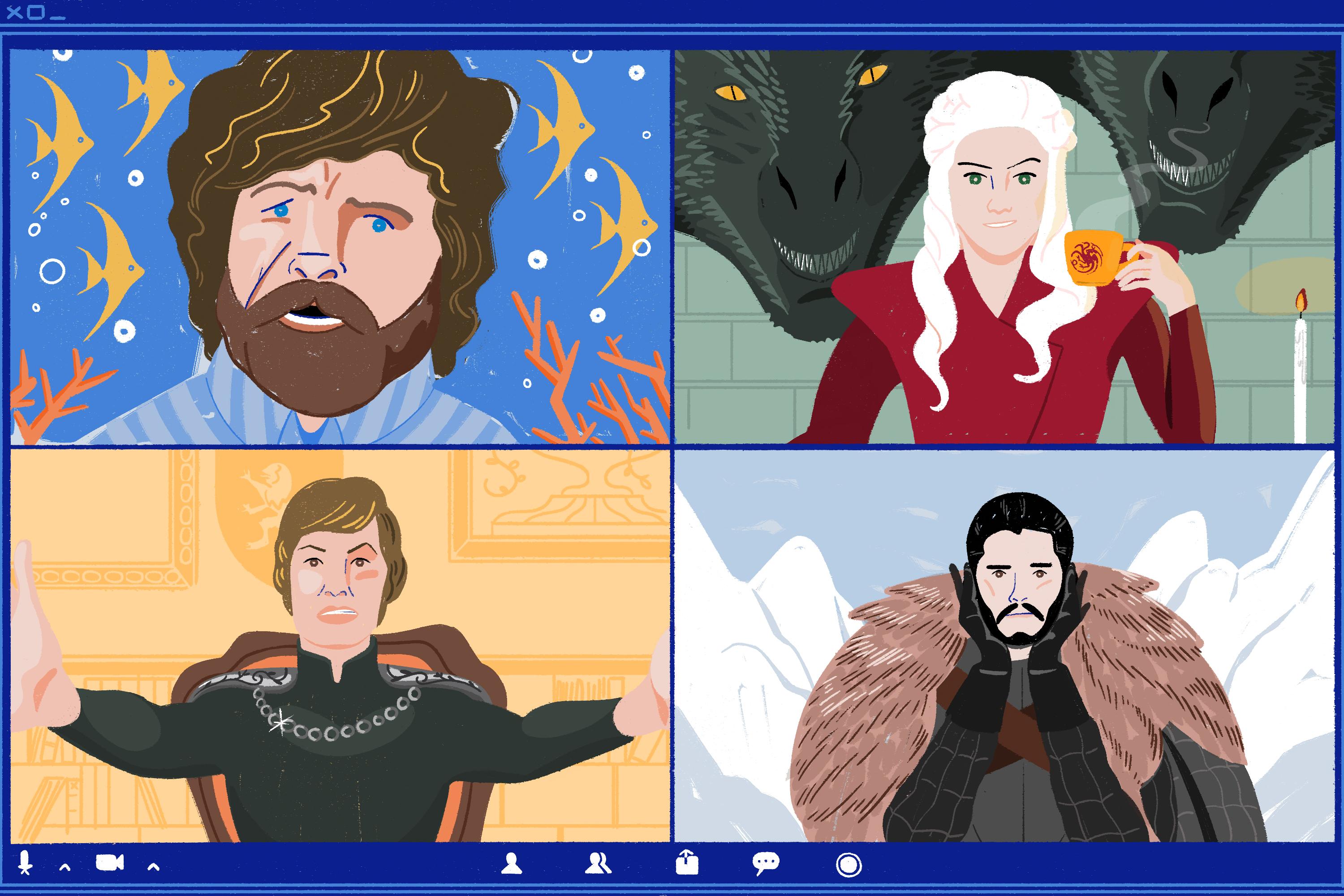The Old Guards and the New: Could a ‘Game of Thrones’–Level Show Happen in 2020?
Audiences are more splintered than ever, and even the most popular television series can’t seem to generate the same level of discussion as ‘Thrones.’ But there’s reason to think the TV monoculture isn’t gone forever.
A year ago this week, Tyrion Lannister gave his now-famous speech, Bran became Bran the Broken and the king of Westeros, Jon Snow ventured north, and Game of Thrones came to an end. In honor of the conclusion of the last piece of monoculture, The Ringer will spend all week looking back on Thrones—focusing not just on its final season, but celebrating its entire eight-season run, reminiscing about its host of memorable characters, and pondering where some of them may be one year later.
“All my memories are poisoned,” Jon Snow muses in A Dance With Dragons, thinking back to his boyhood at Winterfell. By Book 5 of George R.R. Martin’s series, most of the people who populated Jon’s early life are dead, and House Stark’s ancestral seat is a scorched ruin. Even when he casts his mind back to “warmer, simpler days,” he can’t help but dwell on the cold, complicated ones that followed.
Game of Thrones fandom is a little like that. The early episodes of the series weren’t warm or simple, but the public perception of the series was: Despite sporadic slips, the first seven seasons of Thrones enjoyed average Rotten Tomatoes scores between 90 and 97 and average IMDb user scores between 8.8 and 9.3. Remember when Season 5’s Dorne detour was the most disliked stretch of the series?
Then came the final season, which drew record ratings but found far less favor with critics and fans. A year ago Tuesday, series finale “The Iron Throne” concluded one of the least-liked last seasons of any well-liked show—and the past 12 months have sent that season’s average user score even lower than it was in the week after it ended. “Even now, long days later, the memory filled him with a bitter rage,” Martin wrote of Tyrion’s betrayal by his captor Catelyn Stark in A Game of Thrones. The memory of D.B. Weiss and David Benioff’s rush to resolve Season 8 incites a similar sentiment, one that retroactively colors our recollections of the 60-something satisfying Sundays that Thrones fans enjoyed from 2011 to 2017.
But the joy (and, at the end, agony) of Thrones was never limited to the hour a week when we were watching. It flowed from the days of discussion between each episode and the months of anticipation and speculation that preceded each season. Even when the series went south, there was solace in the cathartic collective outrage that followed each episode. And the Thrones discourse soon seeped into topics that transcended the series itself. As Thrones ascended to its place in the pantheon of prestige TV, it became a cultural lingua franca. Even those who weren’t watching—or reading recaps and Reddit threads—were aware of what it was. Thrones analogies suffused every kind of coverage and commentary: When mainstream media members weren’t likening presidential candidates to Thrones characters, presidential candidates were likening themselves to Thrones characters. We could compare anything and everything to Thrones, because we could count on almost everyone getting the reference.
The pervasiveness of Thrones was what set the series apart. Other shows could compete on quality, but none of its contemporaries could equal its omnipresence or its capacity to cross cultural lines. In the waning days of the series, some writers—including my colleagues Alison Herman and Alyssa Bereznak—preemptively eulogized Thrones’s unifying qualities, anointing it the last gasp of the TV monoculture. A year after Thrones went away, we can start to assess what the TV landscape looks like without it. Game of Thrones was the most prominent TV show of the 2010s, but was it the most influential? How transferable is the formula that made it the Red Comet of TV, visible and talked about by everyone at once? And will we ever see a show sustain the same level of interest, or did the idea of the all-consuming series really die with Daenerys?
Preston Beckman, a former head program planner and scheduler for NBC and Fox, takes the long view on TV’s potential to produce another series with Thrones-esque appeal. “After working in the business for 35 years, I always chuckle at these ‘it was a once in a lifetime’ or ‘it can never happen again’ perspectives,” he says.
In some respects, Year 1 of the post-Thrones era has made Thrones seem semi-replaceable. Instead of floundering without its flagship show, HBO thrived creatively, at least, introducing critical and popular hits like Chernobyl, Watchmen, and The Outsider and enjoying ratings growth from holdovers such as Succession and Big Little Lies. On Netflix and Disney+, Stranger Things 3, The Witcher, and The Mandalorian achieved audiences that rivaled that of Thrones, to the extent that we can tell who’s watching what in a time of imprecise or self-reported streaming traffic. Of those three, The Mandalorian probably came closest to Thrones-level ubiquity, thanks both to the built-in appeal of Star Wars and to Baby Yoda’s midichlorian count as a meme master. (Instead of being compared to presidential candidates, Baby Yoda surpassed them in popularity.) And in the past two months, Tiger King and The Last Dance sniffed the Thrones stratosphere as watercooler topics—or would have, if anyone had been working where the watercoolers were.
We haven’t been hurting for TV to talk about, but no single series has filled the conversational vacuum that Thrones left behind. A relay team of networks and streaming services has passed the TV baton from show to show, each of which burned brightly but briefly before fading away. That’s partly a testament to the difficulty of developing the “next Game of Thrones”—a label applied to plenty of shows that didn’t deserve it—and partly a product of industry realities. In accordance with Netflix custom, Stranger Things, The Witcher, and Tiger King each rolled out all of their episodes at one appointed time, shirking the week-to-week model that drives ongoing engagement.
“Streaming shows that drop all at once don’t seem to dominate conversation for as long,” says Rick Porter, who covers television for The Hollywood Reporter. “Everyone talked about Tiger King for like three weeks, but now, only two months after it premiered, it’s mostly background noise.”
Although Stranger Things 3 was reportedly the series’ most popular season, its cultural relevance (anecdotally) doesn’t seem to have skyrocketed along with its ratings and rate of product placement. Some of the past year’s highest-profile shows weren’t constructed with staying power in mind. Chernobyl, Watchmen, and The Outsider were all limited series that came and went within weeks (although The Outsider may have earned an unexpected second season). Tiger King and The Last Dance were documentary miniseries, not epic, scripted stories built to last like Thrones. And the latter two catapulted to prominence at least partly because they arrived at the height of social distancing, when streaming served as a ready replacement for sports, trips to the theater, and other group activities. (In the case of The Last Dance, that timing was intentional.) The pandemic reinstituted the entertainment monoculture, but hopefully not in a way that will last.
Like Beckman, Porter won’t rule out the possibility of another Thrones-type breakout, but even if we set aside the specter of a COVID-caused economic depression, the odds against one have increased. “I’m guessing it could happen, but it’s probably less likely to than it’s ever been,” he says.
While a successor to Thrones wouldn’t necessarily have to have a budget bigger than Wun Wun, only a few deep-pocketed platforms can commit the resources required to take an equally ambitious swing. (In 2017, Variety reported that the final episodes of Thrones would cost $15 million apiece, which The Mandalorian matched.) “It’s not easily replicable, because to do it on the scale of what Game of Thrones did requires a lot of money and, just as important, time,” Porter says. “A traditional, ad-supported network that relies on regular deliveries of content probably couldn’t pull off something of this magnitude.”
Thrones debuted at the end of an earlier and less microtargeted era: According to FX, 532 scripted series aired in 2019, exactly twice as many as the year Thrones premiered. A lower percentage of today’s total appears on broadcast networks or basic cable, and a smaller portion of the overall audience has access to either. Cord-cutting and the streaming wars have segmented spectators, making it more challenging for any single series to own a day or a week and more daunting for any network or streaming series to go all in on one show. Those who wanted to watch The Mandalorian, for instance, had to sign up for a brand-new streaming service. Many millions did, but the streaming network count keeps climbing—HBO Max and Peacock are coming soon—and the average American’s bank account isn’t big enough to gain access to everything.
Thrones benefited from genre storytelling’s movement toward the mainstream, and in the wake of the series’ success, a fantasy setting is no longer an obvious obstacle to mass appeal. But it’s still a tall order to fuse fantasy and mythology with the trappings of prestige TV, as evidenced by its creators’ conflicted feelings about the series’ fantasy elements. Thrones appealed to casual watchers attracted to tits and dragons, but it also offered an expansive cast of complex characters, line after line of sparkling and well-delivered dialogue, and a sprawling scope, making it the kind of crossover, five-tool talent that stands apart from the pack. Its toppling of TV conventions—until it eventually capitulated to them—made each episode an immediate must-watch for anyone who was worried about spoilers, and its string of violent twists seized the spotlight whenever they occurred. As I wrote last year, “One iconic killing at a time, Thrones became known as the show that could shock us.” Given enough episodes, though, audiences can acclimate to anything, and in its final few seasons, even Thrones stopped surprising us, except in unwelcome ways.
That Thrones faltered toward the end, when Weiss and Benioff blew by Martin’s books, is a further testament to the source material that steered the series for the first four-plus seasons. The books are the primary reason why Thrones resists replication: There simply aren’t many unadapted tales of that caliber ripe for the optioning. The preexisting popularity of A Song of Ice and Fire made Thrones an object of anticipation even before its first (failed) pilot was shot, and the lack of written resolution to the saga elevated the TV version into an unusual leading role. Frustrating as the nearly nine-year-long wait for The Winds of Winter has been for book readers, Martin’s inability to complete his epic project allowed HBO to shoulder his series aside. By the end of Thrones, book readers and show watchers alike had the same motivation to tune in, which isn’t the case for fans of Philip Pullman’s His Dark Materials, who know what to expect when watching HBO’s TV adaptation.
The clearest way in which other networks and streaming services are trying to channel Martin’s magic is by taking a page out of HBO’s playbook—or out of another author’s oeuvre. “Thrones was already part of a trend of using well-known, preexisting works as source material for shows, and that’s only accelerated in the past few years,” Porter says. “I don’t think that happened because of the show’s success, but it’s certainly a data point networks and streamers can point to.”
The most obvious symptom of Thrones fever is HBO’s own effort to develop a spinoff; the Targaryen-centric series House of the Dragon is slated to appear in 2022, and Martin’s volumes of Westeros lore may spawn additional shows. But HBO’s first spinoff to enter production never made it past a pilot, and House of the Dragon will have to overcome the prequel curse.
“I think if you try for another Game of Thrones, it will fail,” Beckman says. “Even HBO will find out that doing a prequel doesn’t guarantee the same audience as the original. I think when you’re not trying, you have a better chance of stumbling on the next phenomena.”
Countless home run hitters have insisted that they didn’t try to hit home runs; only a few sluggers admit to swinging for the fences, sometimes tongue in cheek. In September 2017, Amazon Prime stepped up to the plate and called its shot like Babe Ruth, copping to a strategy of pursuing a successor for Thrones. “I do think Game of Thrones is to TV as Jaws and Star Wars was to the movies of the 1970s,” said then–Amazon studios head Roy Price. But Amazon’s strategy for finding the next Thrones sounded almost tautological: “The biggest shows make the biggest difference around the world,” Price said, which seems self-evident but doesn’t offer any hints about how to hit it big.
A month after making those comments, Price resigned amid sexual harassment complaints. But Amazon has invested hundreds of millions of dollars in its forthcoming Lord of the Rings prequel series, with a Wheel of Time adaptation also on the way. A small-screen take on Isaac Asimov’s Foundation is coming to Apple TV+, and Netflix is working on a Narnia reboot and an adaptation of Leigh Bardugo’s Grisha fantasy trilogy. TV adaptations of Stephen King’s The Dark Tower and Patrick Rothfuss’s The Kingkiller Chronicle, which were dropped by Amazon and Showtime, respectively, may still land somewhere. The Thrones copycat cottage industry is in full swing. The Witcher’s popularity proved that the public’s tolerance for fantasy hasn’t been exhausted, but there’s some irony in trying to strike gold again by following in the footsteps of a show that succeeded by breaking the wheel.
Maybe the streaming war’s winners, boosted by quarantining TV viewers, will corner enough of the market to make the monoculture come back. Earlier this month, Disney announced that its streaming service had acquired 54.5 million subscribers to date, less than six months after launch. In April, Netflix boasted about doubling expectations for new subscribers in the first quarter of 2020, raising its total to 182 million subs worldwide. The Netflix Bump gets bigger by the year, and some series still moving along the streaming-service assembly line will be the beneficiary, like Tiger King and The Witcher were.
Any series aspiring to the, er, throne relinquished by HBO’s blockbuster can console itself in the knowledge that the titan of 2010s TV wasn’t a sensation from the first episode on: It took a few years for the series to become a cultural juggernaut. As Disney+ adds subscribers, The Mandalorian may be primed for a second-season leap. Adorable as he was, there was only so much to analyze about Baby Yoda, and the first season’s semi-serialized structure limited the scope of the plot. But a succession of buzzed-about casting announcements has kept the show in the news, and rumors of possible spinoffs point to a more central role for the series in the Star Wars franchise’s future.
In 2020, the TV audience is more splintered than ever, but that won’t stop networks with Iron Bank–sized budgets from trying to pull off the improbable. As Lord Tywin said in A Storm of Swords, “The fruits of victory await division.” But maybe Ser Barristan summed up the state of TV better in A Dance With Dragons: “Dying is easy, but victory comes hard.” He soon proved his own point.
Disclosure: HBO is an initial investor in The Ringer.

